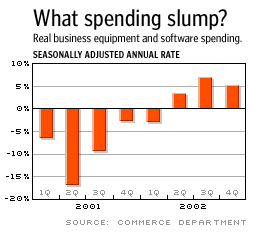NEW YORK (CNN/Money) -
Contrary to popular belief, U.S. businesses have been spending money lately, as a government report Thursday helped confirm -- but that's not doing much good yet for the 8.3 million Americans who are unemployed.
The Commerce Department said new orders for durable goods, such as cars and computers meant to last three years or more, jumped 3.3 percent in January, confounding economists' expectations.
Orders for non-defense capital goods -- including everything from factory and construction equipment to computers -- rose 2.1 percent. Excluding aircraft, that sector jumped 5.4 percent.

Economists weren't exactly jumping up and down about this particular report -- durable-goods data are notoriously volatile, especially in the first month of a quarter, when many businesses place orders for all of that quarter.
"We won't know what the trend is until we have several months behind us," said James Glassman, senior U.S. economist at J.P. Morgan (not the same James Glassman who wrote Dow 36,000 and is now a scholar at the American Enterprise Institute).
But Glassman and other economists noted that the report seemed to confirm what other data have been showing recently, something that seems to get lost in the shuffle -- businesses are spending more money, however hesitantly.
For one thing, the "new orders" component of the Institute for Supply Management's closely watched survey of business activity has risen four out of the past five months, hinting at increased demand for manufactured goods.
And in the fourth quarter, another canary in the capital investment coal mine, the "non-residential fixed investment" component of gross domestic product (GDP), rose 1.5 percent, the first such gain since the third quarter of 2000.
Though businesses still aren't building office buildings -- the "structures" component of fixed investment fell for the fifth straight quarter -- they've been buying equipment and software ever since the second quarter of 2002.
| Related stories
|

|
|
|
|
"The question is often asked: When will capital spending kick in? I answer that it already has," said John Silvia, chief economist at Wachovia Securities.
Conventional wisdom holds that businesses are sitting on the sidelines, delaying spending and hiring plans until the conflict in Iraq has passed.
Some economists also say corporations still have a lot of the mess from the popping of the late-1990s investment bubble to clean up, including high levels of debt and more equipment than they need. According to this view, ending the war in Iraq is not necessarily going to lead the economy to the promised land.
But while businesses may not be gearing up to build new plants, they're at least spending money to replace old equipment in a bid to stay competitive.
And businesses grew their inventories in the last three quarters of 2002, after five straight quarters of inventory cutting -- not the kind of behavior that reflects an extended downturn in business investment.
"We saw a lot of healing going on in 2002, and nobody gives any credit to it," said Salomon Smith Barney economist Steven Wieting.
The conventional wisdom seems more accurate when it comes to hiring. New claims for unemployment benefits jumped again last week, the Labor Department said Thursday, staying well above 400,000, a level many economists think means the labor market's getting worse.
The unemployment rate has hovered between 5.7 and 6 percent since December 2001, and there are about 1.6 million fewer people on employers' payrolls than in March of that year.
In fact, the recent spending on new technology has in part been designed to increase efficiency, to help businesses produce more with fewer people. As a result, productivity -- a measure of output per hour -- rose 4.7 percent in 2002, the best performance since 1950.
That should be good news for corporate profits, leading to increased spending and hiring when the economy starts to pick up. In the meantime, however, pinched by soaring oil costs and higher prices for other commodities, and unable to pass those costs on to consumers, businesses seem likely to stay lean.
"We will continue on this jobless path, where we're not creating enough jobs to make a real difference to the economy, for at least another six to nine months," said Anthony Chan, chief economist at Banc One Investment Advisors.

|

